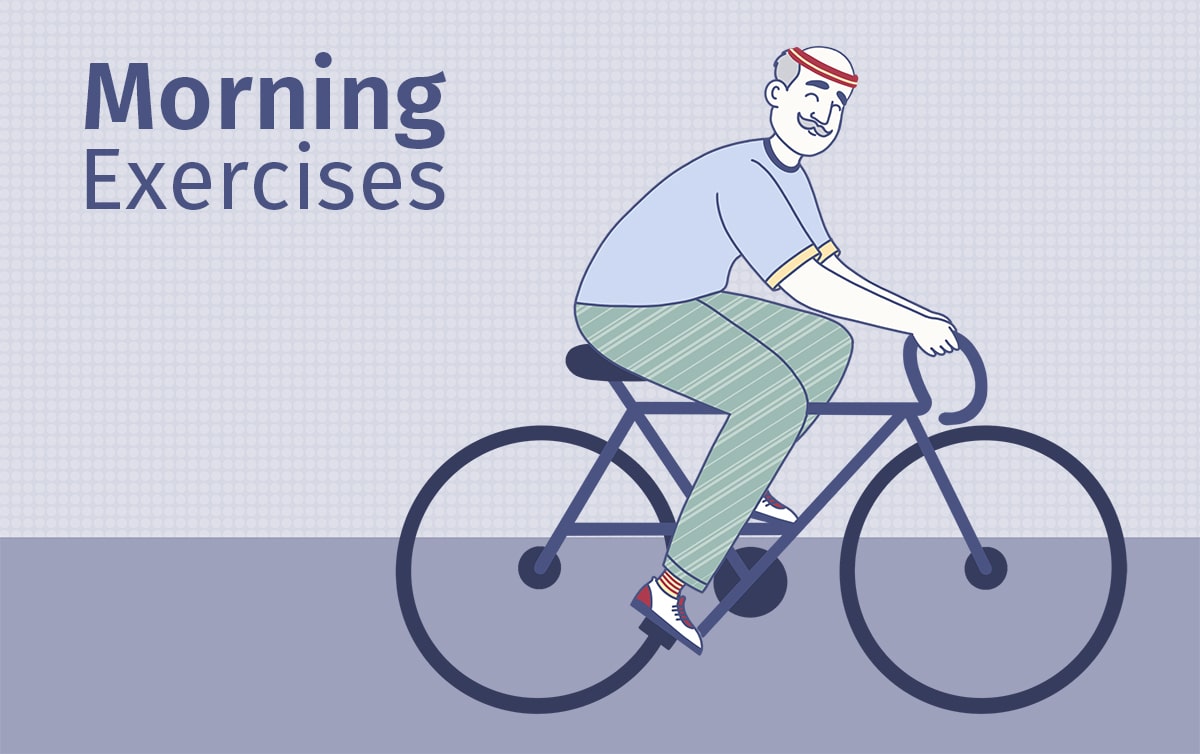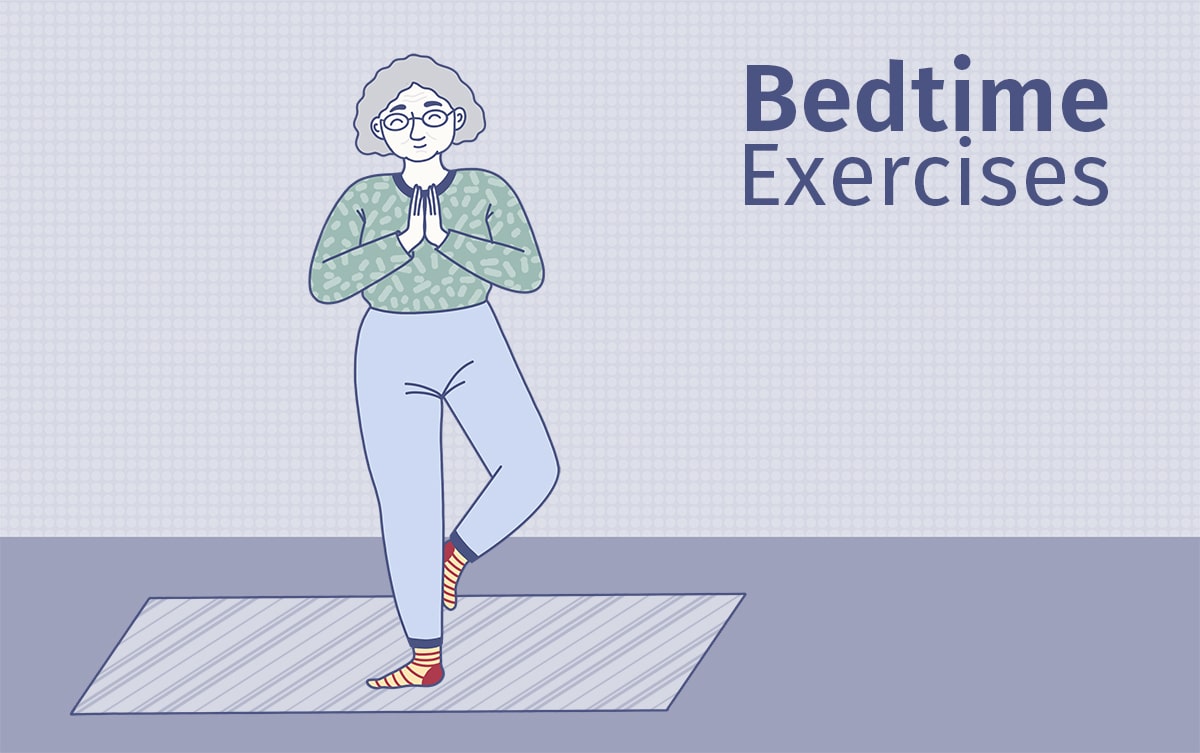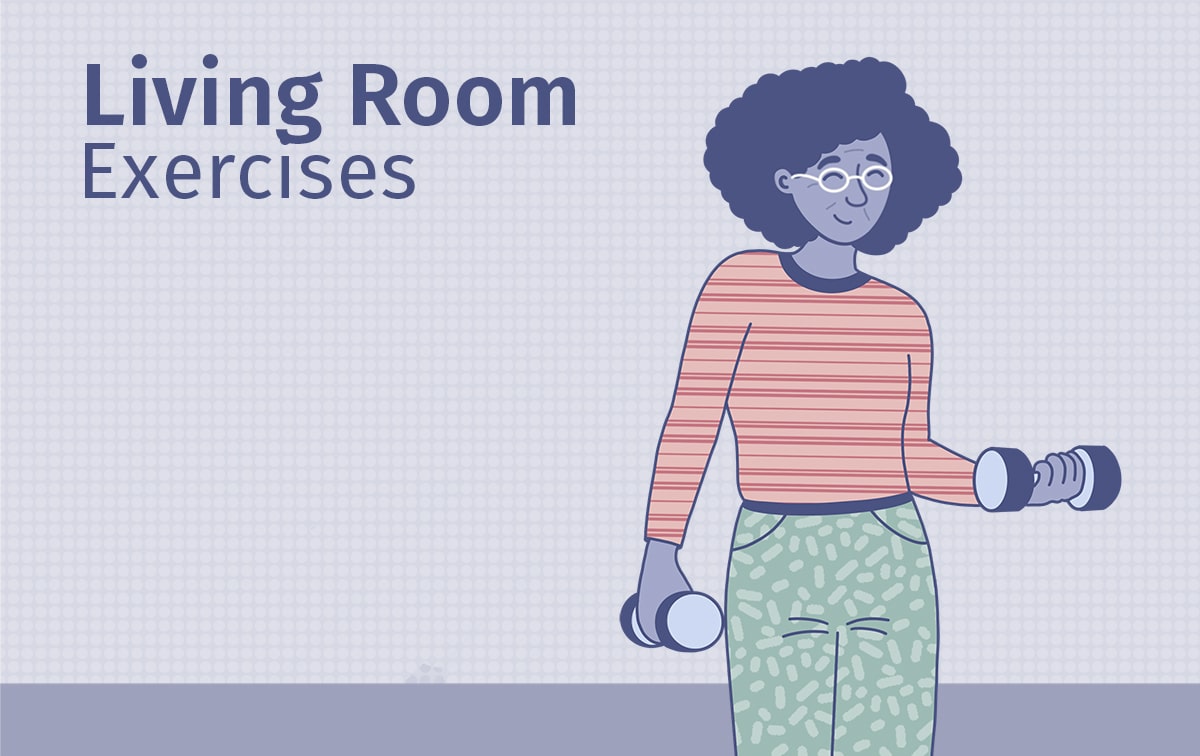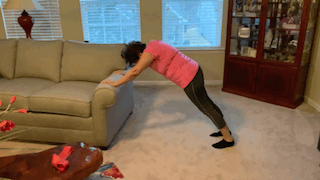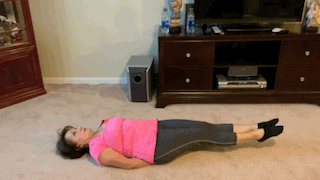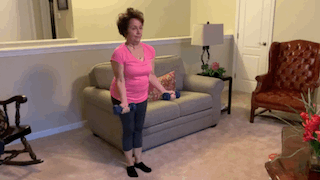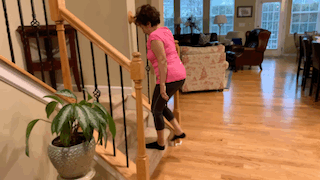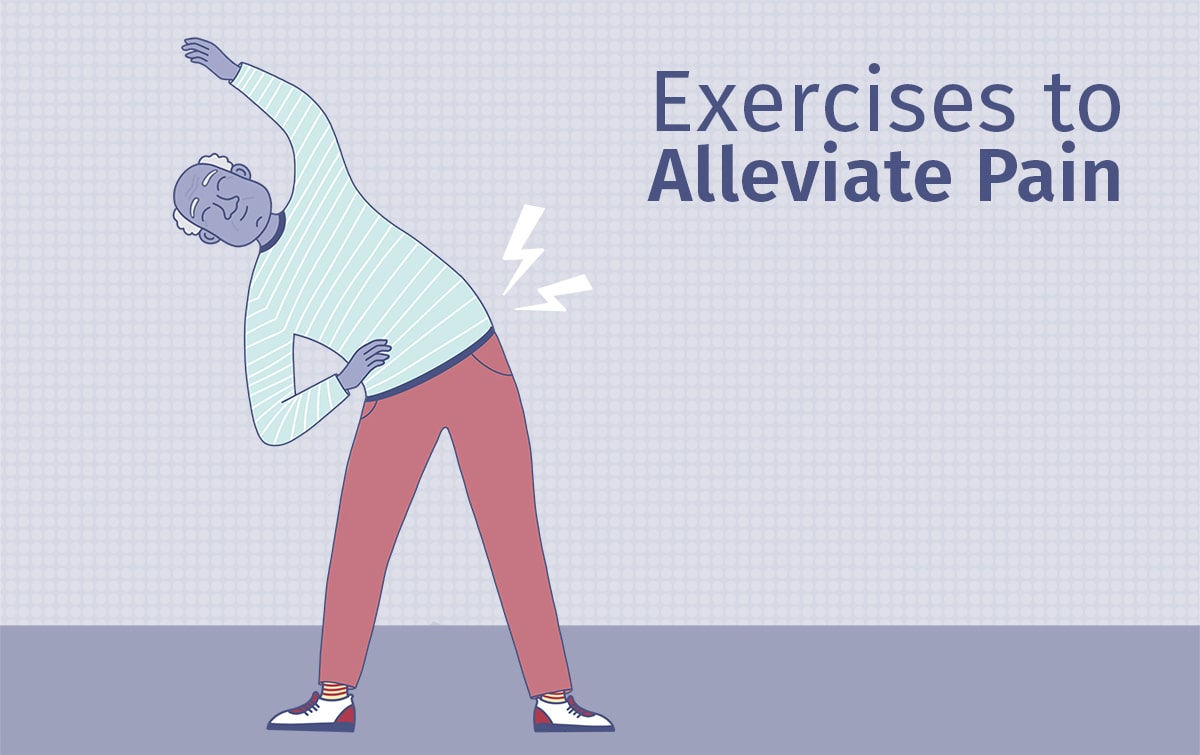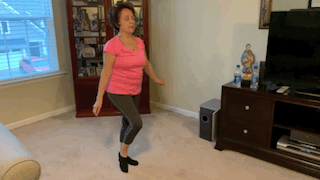You don’t need us to tell you that exercise is good for one’s health. Public health campaigns and high school gym teachers have been hammering home that message for years. But fewer people realize exercise can offer distinct perks at different stages of life.
Regular physical activity offers people in their golden years a host of benefits, from stronger bones to improved cognition and better sleep. You don’t need to pound the pavement or spend hours in the gym each day to reap these benefits. The perks of exercise can be found via a huge range of activities including cycling, swimming, walking, strength training, stretching, and more.
Below, we’ve detailed everything you need to know about exercise for seniors. We’ll walk you through the many benefits of exercise at this life stage plus a range of accessible activities. We’ve also rounded up several experts’ best recommendations for exercises that relieve aches and pains all over the body.
Finally, we’ll outline some safety tips for exercise so you can stay fit and active for years to come. Let’s get to it!
Edie Dolan (aged 70+), featured in the clips below, has been working with personal trainer Kate Meier for over 2 years. Meier says, “When we started working together, Edie’s osteoporosis was progressing rapidly. After just six months, they found that her osteoporosis progression had stopped and it has not progressed again since we started working together.” This is a true testament to the benefits of resistance training in older adults!
Relationship Between Sleep and Exercise
Here’s one good reason to get a move on: Research routinely finds links between physical activity and quality Zzzs. Per Johns Hopkins Medicine, regular physical activity could support sleep in several ways.
For instance:
- Exercise can help people fall asleep faster and obtain better-quality sleep while they doze.
- Moderate aerobic exercise increases what’s called slow wave sleep, a.k.a. deep sleep, in which the brain and body repair and rejuvenate themselves. This may be especially beneficial for seniors, because aging is associated with a reduction in slow wave sleep.
- Physical activity can help relieve anxiety and stabilize mood. This decreases the chances that stress will provoke insomnia.
- Exercise raises a person’s core body temperature. Initially, this temporary rise in body temperature has an energizing effect. But 30 to 90 minutes after exercising, body temperature drops. This could prepare the body for sleepiness. For this reason, some people find they sleep best after exercising in the hours leading up to bed.
- This might seem obvious, but it’s worth noting that exercise tires out the body. This can make it easier to drift off at night.
Put all these benefits together, and you’ll see why exercise can have a powerful impact on sleep. It’s why the Cleveland Clinic states that “physical activity can be as effective as prescription sleep meds.” Indeed, a 2020 study found exercise is associated with reduced use of sleep medications.
Benefits of Exercise for Seniors
Better sleep isn’t the only perk associated with regular physical activity. Per the National Council on Aging, there are several more benefits of exercise for seniors. For example, exercise could help:
- Prevent and/or mitigate chronic disease. Exercise helps protect against a range of chronic illnesses, including cardiovascular disease, colon cancer, diabetes, high blood pressure, and more. For people who already have a chronic illness, regular activity can help ease symptoms. For instance, people with cardiovascular disease can benefit from the fact that exercise can improve heart health in several ways, from strengthening the heart to lowering blood pressure and reducing “bad” cholesterol.
- Support cognitive health. Regular exercise isn’t just good for our bodies; it can also protect our minds. In fact, research suggests physical activity could reduce cognitive decline. One 2019 study found exercising every day for 30 minutes helped reduce the signs of Alzheimer’s in people with a high risk for the disease.
- Prevent bone loss. A decrease in bone density is a natural part of aging. But strength training can help prevent this decrease and could even restore bone density. Strong bones support balance and are less prone to fractures or breaks. Given that falls and broken bones are common causes of reduced independence in seniors, maintaining your balance and coordination could empower older folks to live independently for longer.
- Relieve osteoarthritis pain. Getting a move on could reduce the pain and stiffness that are common for people with arthritis. That’s because exercise helps strengthen the muscles that support joints all over the body, thereby relieving pressure on those joints. Exercise can also reduce joint inflammation, which can otherwise provoke the pain and stiffness associated with osteoarthritis.
- Boost immunity. Research repeatedly finds regular exercise can improve immune system function. A 2018 study found links between moderate exercise and a lower incidence of respiratory illness as well as taking fewer sick days from work. Researchers are still trying to understand exactly why exercise supports immunity. Possibly, it’s because exercise reduces inflammation and improves immune cell performance.
- Improve mood. Not only does exercise support cognitive wellbeing, but it’s also good for your emotional health. Exercise releases feel-good hormones that can help relieve anxiety and depression, promote relaxation, and create a general sense of wellbeing. They don’t call it a “runner’s high” for nothing–and running isn’t the only exercise that offers an endorphin rush.
Types of Exercises for Seniors
Morning Exercises
These aerobic exercises are ideal for morning activity because they involve more physical exertion than some of the mellower activities described later on. Few people want to save the most challenging part of their day for the evening. Get it over with and give yourself a jolt of energy to start each day off right.
- Cycling. Riding a bike is a form of aerobic exercise that is low-impact, meaning it doesn’t cause much strain on the body and it doesn’t come with a high risk of injury–making it an ideal form of exercise for seniors. Among other benefits, cycling can build strength, increase endurance, improve balance, enhance flexibility, increase cardiovascular fitness, support joint mobility and coordination, and decrease anxiety, depression, and stress. By tiring out your body and improving your mental state, cycling could set you up for sound sleep at night.
- Walking. Walking may not be the most dazzling form of exercise, but it still offers exciting benefits. A brisk walking routine can improve cardiovascular fitness, strengthen bones and muscles, enhance energy levels, improve balance and coordination, reduce stress, boost mood, prevent or manage a variety of health conditions (including heart disease, high blood pressure, and type 2 diabetes), and improve sleep. The faster and more often you walk, the better the benefits.
- Swimming. Swimming is a great way to obtain a low-impact, full-body workout. Moving through water is harder than moving on land, so your body will feel the burn without putting undue pressure on joints. In addition to improving strength and endurance, swimming can increase energy levels, reduce stress, lower the risk of chronic diseases, and improve sleep patterns.
- Water aerobics. Much like swimming, water aerobics (also known as “aqua aerobics”) allow you to work out your entire body, build strength and endurance, and reduce the stress that could interfere with sleep–all without putting undue wear and tear on muscles and joints.
- Jumping jacks. Jumping jacks offer a full-body challenge that strengthens muscles and bones while improving cardiovascular fitness. (Note that people with lower-body injuries or osteoarthritis might want to avoid this exercise.) Curious about jumping jacks but concerned about impact? Try a low-impact version: Stand with your feet under your shoulders and your arms bent at a 90-degree angle (palms facing forward). Step your right foot out to the side and lift your arms overhead. Return your right foot and arms to the starting position, then step out with the left foot and lift the arms back overhead. That counts as one rep; repeat for as long as you’re able and build up from there.
Bedtime Exercises
For a bedtime routine that gets your body ready for sleep, try incorporating the following stretches and wind-down exercises into your evening. Compared to the morning exercises outlined above, these activities require less exertion and are gentler on the body.
Yoga
A 2019 study found yoga is particularly well suited to seniors. It’s a low-impact activity that simultaneously strengthens muscles, enhances flexibility, and promotes balance and coordination. Additional research has found yoga could reduce hypertension, strengthen bones, boost mood, and offer a calming effect that helps practitioners lay down their worries before bed.
Try these poses as part of a nighttime wind-down routine.
- Tree Pose. Stand up straight and shift your weight onto your left foot and leg. Slowly raise the sole of your right foot toward your left leg, pausing at the ankle, calf, or thigh. (Avoid pressing into the left knee.) Open your right knee and hip out to the right side. Press your palms together and hold them near the center of your chest. Hold this pose for 30 seconds, re-stabilizing as needed. Repeat on the other side.
- Mountain Pose. Considered the foundation of all standing poses in yoga, mountain pose offers a great reset for your posture and mind. Stand tall with your feet hip-width apart, toes spread wide, and weight balanced across the full surface of each foot. Extend your arms by your side with the palms facing forward, draw your shoulders down away from the ears, and imagine squeezing your shoulder blades toward each other on the back. Lift the center of your sternum toward the ceiling without sacrificing your posture. (The crown of the head should align directly over the pelvis.) Breathe deeply and slowly.
- Bird Dog Pose. This classic yoga pose builds core strength while improving balance, enhancing posture, and relieving lower back pain. Start this pose on all fours, aligning your wrists directly under your shoulders and your knees directly under your hips, with your toes pointing straight behind you. Gaze down at the mat so the back of your neck remains straight. Engage your abs and lift your right leg, pressing your right foot back toward the wall behind you. If you’re up for more of a challenge, extend your left arm out in front of you at the same time. Breathe deeply. Gently lower your right leg and left arm, then repeat this move with the left leg and right arm.
Resistance Bands
Resistance bands come in a variety of strengths, lengths, and sizes, but they all have several things in common: They’re ribbons of stretchy material that are affordable, foldable, portable, and offer several health benefits.
A 2017 meta-analysis of 19 studies found resistance bands can improve seniors’ flexibility and balance, while a smaller 2021 study found training with resistance bands improved balance, physical function, and mental health. Meanwhile, a 2020 study found people with degenerative knee arthritis who used resistance bands three times a week for four weeks experienced less pain and greater knee function.
Ready to get started with resistance bands? Put together a mellow pre-bedtime workout with these exercises.
- Standing biceps curl. Stand with both feet planted on the center of a resistance band. Extend your arms down along your sides with the palms facing forward, gripping the band’s handles. Slowly bend your elbows (keeping them next to your sides) and draw your hands up toward the shoulders as you squeeze your biceps. Slowly release the arms and return to the starting position, then repeat.
- Lateral raise. To perform this shoulder-strengthening exercise, use a circular resistance band. Stand with your feet slightly wider than hip-width apart, and plant your right foot over the inside of the band. This will create a loop. Grab the other end of the loop with your left hand, straighten your arm, and slowly raise your left arm out to the side. Try not to let your shoulder “hunch up” toward your ear. Repeat for two or three sets of 15 to 20 reps and then switch sides.
- Clamshell. This glute- and hip-strengthening exercise is performed lying down on your side. From that position, place a circular resistance band around your thighs (a few inches above the knees), which should be drawn together at a 90-degree angle. Keep your feet together as you lift the upper knee approximately 8 to 10 inches up and away from the lower knee. Hold the extended position for a few seconds, then slowly lower your knee back to the starting position. Repeat for 10 reps or so and then switch sides. Note: People with knee injuries should avoid this exercise.
Pilates
Pilates has been around since the early 1900s. This style of exercise and body conditioning was originally designed for dancers, but its benefits extend to people of all stripes. Pilates emphasizes strengthening the core muscle groups; practicing precise, balanced movements; and breathing intentionally. The practice promotes proper alignment throughout the body, which can ease aches and pains.
There are many pilates routines and exercises, some of which require props and some that don’t. A quick YouTube search should yield an at-home routine that’s suited to your experience level.
Tummy Twists
Otherwise known as “abdominal twists,” tummy twists strengthen the core while strengthening and mobilizing the spine. The move is performed on the floor:
- Start by sitting on the floor with your knees bent and your feet on the floor. Lean back slightly until you feel your abs engage.
- Bring your palms together in front of your chest and twist your torso from side to side while keeping your lower body still. As you twist to the right, draw your right elbow toward the floor without releasing your hands at your chest. Then repeat on the left side.
- Aim for two or three sets of 10 to 12 reps.
- For an added challenge, lift up your feet and hold the calves parallel to the floor as you twist.
Overhead and Side Stretching
Stretching your sides helps loosen up the body while strengthening the intercostal muscles, or the muscles between the ribs. You can target these muscles from a seated or standing position. Here’s how the seated version works:
- Sit on a sturdy chair with your feet planted flat on the floor.
- Align your ears over your shoulders and your shoulders over your hips.
- Raise your right arm overhead and bend your upper body to the left. Continue to face straight ahead so your upper body forms a reverse “C” shape. You should feel a stretch along the right side.
- Hold the stretch for approximately 20 seconds.
- Repeat the stretch twice before switching to the other side. Repeat this process twice with the left arm overhead.
Exercises for your Living Room
If you are limited in mobility or don’t have access to a gym (or you’re avoiding gyms due to Covid), that doesn’t mean physical activity is off-limits. Here are some simple exercises you can do from the comfort of your own home.
Modified Push Ups
The classic push up is a very challenging exercise, while modified push ups are more accessible to people of all fitness levels. Just like a regular push up, modified push ups work the pectoral, core, and triceps muscles. Perform this exercise with the aid of a sturdy chair or wall:
- Stand facing the wall with your feet hip-width apart, then place both palms on the wall at shoulder height.
- Contract your abdominal muscles and slowly bend your elbows while moving your chest toward the wall. Keep your back straight as you do this.
- Return to the starting position and repeat.
Leg Raises
Want to strengthen your core and create more flexibility in the hips without even standing up? Give lying leg raises a try:
- Begin by lying on your back on the floor with your legs extended.
- Support your pelvis by placing your hands under your lower back and glutes, palms facing down.
- Engage your core and slowly raise your legs toward the ceiling while keeping the legs extended and pressing your thighs together. Be sure to keep your back pressed into the ground and avoid arching your lower back.
- Lift until you’re no longer able to keep the legs straight, then lower your legs back down to the ground.
- Repeat 10-15 times.
Dumbbell Strength Training
Strength training with dumbbells can increase upper body strength, enhance joint health, improve balance and stability, and even increase bone density. There are tons of dumbbell exercises and routines, each of which targets different muscles or works toward a different goal, such as increasing strength or improving balance.
No matter which move(s) you choose, remember that proper form is key to avoiding injuries and pain. Begin with lightweight dumbbells and gradually increase the weight as your strength grows. To get started, check out this 15-minute dumbbell routine for seniors from SilverSneakers.
Step-Ups
Step-ups were all the rage back in the 1980s, and they’ve since made a comeback. This resistance exercise strengthens the glutes and legs (especially the quadriceps and hamstrings). All you need to perform it at home is a couple of stairs or a step stool.
- Stand in front of the stairs (or stool), then lead with your right foot to step up onto the step. Plant your whole foot on the step and step up as you engage your abdominal muscles and keep your spine straight.
- Use the same leg to step back off the stair and return to the starting position.
- Repeat this process, leading with the other leg.
- Perform as many repetitions as you can without sacrificing form. Be sure to alternate the leading leg with each step up.
Knee-to-Chest
This simple stretch helps relieve tension in the lower back while improving range of motion, strengthening the abs, and boosting circulation.
- Start by lying on your back with your knees bent and the soles of your feet on the floor.
- Draw one knee toward your chest and interlace your fingers around the shin. (Don’t hold onto the knee joint.)
- Use your hands to gently pull your leg closer to your torso while relaxing your lower back and legs.
- Hold the stretch for a few seconds, then return your foot to the floor.
- Repeat this move on the other side, then repeat the stretch on both sides approximately 10 to 15 times.
Leg Kicks
This pilates-inspired exercise offers a low-impact way to stretch the quads while improving balance and strengthening the core, glutes, and hamstrings. Start with beginner-friendly single-leg kicks and gradually work your way up to double-leg kicks.
To perform a single-leg kick:
- Lie on the floor on your stomach with your legs touching. Rest your forehead on your hands.
- Lengthen your spine and slide your shoulders down and back.
- Press your pelvis into the floor and engage your abs.
- Point your toes and raise both knees slightly off the floor.
- Bend your left knee as you flex your left foot and squeeze your glutes.
- Straighten and lower the left leg.
- Repeat with the right leg.
- Perform 3 to 6 reps on each side.
Exercises to Help Alleviate Pain
We spoke with several experts to get their recommendations for the best low-impact exercises that help alleviate different types of pain. Whether you’re dealing with hip, neck, knee, back, leg, wrist, or shoulder pain, these moves have got you covered.
Hip Pain Relief
Piriformis Stretch
Jennifer Perry, physical therapist, DPT, says stretching the piriformis (a muscle in the hip/buttock area that supports hip mobility) “improves flexibility and mobility in the hip and can assist with decreasing pain in the back and/or hip.”
Here are Perry’s tips for stretching the piriformis:
- Lie on your back.
- Bend one knee up toward your chest and cross the opposite ankle over your knee.
- Gently hug your knee towards your opposite shoulder until you feel a mild to moderate stretch in the outer hip. Hold for 10 to 20 seconds.
- Repeat this stretch 3 to 5 times on both legs.
Hip Flexor Stretch
Brett Edmunds, a chiropractor at Paramount Health, says hip flexor stretches help “improve flexibility and reduce pain in the hip area.” The hip flexors are a group of muscles located near the front of the hip. They allow people to move their legs and knees up toward the upper body.
Follow Edmunds’ tips to stretch your hip flexors:
- Start by kneeling on the ground with one knee bent touching the floor and the other leg straight out in front of you. You should feel the stretch in your Achilles heel as your foot extends away from you.
- Lean forward from your waist, keeping your back straight, until you feel a stretch in the front of your thigh. Hold for 30 seconds.
- Repeat the stretch on the other leg.
Neck Pain Relief
Neck Rotations
Simple neck rotations can ease neck pain and stiffness, Edmunds says. Here’s how to safely perform this exercise:
- Start by sitting or standing with your spine straight and your head aligned over your shoulders.
- Slowly rotate your neck to the right. Hold for a few seconds, then return to the starting position.
- Repeat this movement on the left side.
- Repeat the rotation on both sides several times until you feel some loosening.
Neck Stretches
Dr. Kristina Hendija, a medical doctor and medical advisor at Beardoholic, also recommends neck stretches as a strategy for relieving neck pain. While Edmunds’ neck stretch involves rotating the head side to side, Hendija’s calls for tilting the head forward and back. This “helps to alleviate pain and stiffness from poor posture,” she says.
Here’s how to perform this neck stretch:
- Stand straight with your arms by your sides.
- Slowly tilt your neck backward as far as is comfortable. Ideally, you’ll be looking straight up at the ceiling. Don’t tilt your head this far back if you experience pain.
- Tilt your head forward until you’re looking at your feet. Try to tuck your chin against your chest.
- Repeat this sequence 10 to 15 times.
For best results, combine this neck stretch with the neck rotations described above. Hendija also recommends making circles with your head–”about 10 in each direction.”
Knee Pain Relief
Side Leg Raises
Dr. Jacob Hascalovici, MD, PhD, says side leg raises help strengthen the hips, which creates greater mobility in the knees and helps alleviate knee pain. He explains: “When your hips, thighs, and knees aren’t well-aligned, your knees end up bearing additional weight and pressure. This is why hip-strengthening exercises are helpful for knee pain.”
Here are Hascalovici’s instructions for performing side leg raises:
- Lie on your side with your legs stretched out.
- Rest your head on one arm and place your other arm on the floor to stabilize your body.
- Slowly and with control, lift up your top leg. Once you’ve reached a point that feels challenging, hold the position before slowly lowering your knee back down again.
- Try 30 repetitions before switching sides and repeating the process with the other leg.
Back Pain Relief
Cat-Cow Pose
Hascalovici says the cat-cow yoga pose is especially “useful for warming up the spine and relieving muscle tension in the back.” He explains: “Having a strong and flexible central spine can help decrease lower back pain. … In fact, studies have shown that regular yoga practice can lead to statistically significant improvements in flexibility and strength.”
To perform cat-cow pose, follow Hascalovici’s instructions:
- Start on all fours with your hands and knees on the ground. Keep your spine neutral.
- As you take a deep inhale, lower your belly and look up. Hold for a few seconds.
- Exhale and tuck your tailbone under, imagining your bellybutton drawing in toward your spine as you arch your back like a cat.
- Repeat the stretch as you feel the tension in your back relax.
Paraspinal Stretches
Kent Probst, a kinesiotherapist, says “low back pain that is caused by muscle tightness can be alleviated by stretching the paraspinal muscles of the low back.” The paraspinal muscles make up three muscle groups whose job it is to support the back. When these muscles get tight and stiff, they can cause lower back pain.
Stretching out the paraspinal muscles is easy. Here are Probst’s tips:
- Lie on your back and pull both knees to your chest, stopping when you feel resistance or pain.
- Hold the stretch for 30 seconds and focus on relaxing your back.
- Repeat this stretch 3 to 5 times.
Windshield Wiper Stretch
Sherry McAllister, DC, president of the Foundation for Chiropractic Progress, says this stretch can loosen up the lower back, thereby reducing pain.
Here are McAllister’s instructions:
- Perform this stretch on a bed or on the floor.
- Lie on your back with your knees bent and feet flat on the floor (or bed).
- Engage your core and gently lower both knees to the left side (feet still on the ground).
- Raise your knees back up toward the ceiling (feet still on the ground) and then lower them to the right side.
- Continue to “windshield wiper” your legs for 8 reps on each side. Move slowly and remember to breathe.
Leg Pain Relief
Seated Hamstring Stretch
Po-Chang Hsu, M.D., M.S., and Medical Content Expert, recommends a seated hamstring stretch to ease leg pain. “This exercise targets the leg muscles and works well to relieve sciatica pain,” Hsu says. “It may also help seniors keep their legs flexible and prevent pain.”
Follow Hsu’s instructions to perform this stretch:
- Sit on the edge of a chair. One foot should remain flat on the floor with the knee bent to 90 degrees. The other leg should be stretched out in front, resting on its heel.
- Lean forward slowly, keeping the back straight. You should feel a gentle stretch along the back of the extended leg.
- Hold this pose for approximately 20 seconds. Repeat with the other leg.
- Repeat the stretch three times on each leg.
Calf Stretch
Dr. Brittany Ferri, PhD, MS, Medical Advisor at Medical Solutions BCN says “many falls come from tight calf muscles, which prevent people from fully straightening their legs when walking.” For that reason, it’s critical to loosen up the calf muscles with regular calf stretching.
Ferri recommends this simple stretch:
- Stand facing a wall with your feet hip-width apart.
- Place the toes of one foot against the wall.
- Lean forward toward the wall until you feel a stretch in the calf.
- Hold for approximately 20 seconds, then repeat with the other leg.
Leg Swings
Hendija says leg swings help “promote circulation in the lower extremities and help stretch the hip muscles, which may be tight or painful from prolonged sitting.”
Here are Hendija’s tips for performing this move:
- Stand beside a wall (or a sturdy table or chair) and balance yourself with your left hand.
- Swing your right leg forward as if you’re kicking a ball. Kick as high as you can without losing balance or moving the left side of your body.
- Swing the leg back behind you as far as you’re able.
- Repeat this move 10 to 15 times, then switch legs.
Seated Ankle Circles
“This exercise can relieve pressure and tightness around the ankles from prolonged periods of… standing or using tight footwear,” Hendija says.
Here’s how it works:
- Sit in a chair with your spine straight and both feet on the floor.
- Extend your right leg (either straight out or with your knee bent and the foot just off the ground) or cross it over the left leg.
- Make circles with your right ankle, keeping the rest of your leg as still as possible. Aim for 10 circles in one direction and 10 circles in the opposite direction.
- Return the right foot to the floor and repeat this exercise with the left leg.
Wrist and Hand Pain Relief
Wrist Bends
Hsu says wrist bends are especially helpful for people with arthritis in their hands, because they promote flexibility in the hands and wrists. This stretch “targets the wrist joints that often become immobile due to arthritis,” Hsu says.
Follow Hsu’s tips for performing this stretch:
- Sit in a sturdy chair in front of a table or desk.
- Place the right elbow of one arm on the tabletop with the fingers pointing toward the ceiling and the palm spread wide.
- Use the left hand to slowly and gently push the right palm backward. Stop pushing once you feel a stretch and hold the stretch for five seconds.
- Repeat 3 to 5 times, then switch arms and repeat on the other side.
Count to 10
Belina Calderon Nernberg, CEO at 1Heart Caregiver Services LLC and 1Heart Franchise, recommends this exercise to anyone with arthritis or stiffness in the wrists.
Here’s how it works:
- Hold both hands out in front of you.
- “Count to 10” by tracing the numbers 1 through 10 in the air in front of you. As you trace the numbers, stabilize your forearms, wrists, and shoulders so your wrists are doing the work. If it’s easier to perform this exercise using one hand at a time, that’s fine.
- Repeat this exercise 5 times.
Shoulder Pain Relief
Shoulder Rolls
“Shoulder rolls help to warm up the shoulder girdle,” Hendija says. “Proper form helps to maintain flexibility and mobility in a full range of motion.”
Follow Hendija’s tips to perform this exercise:
- Stand up straight with your arms extended by your sides.
- Lift your shoulders and roll them forward, all the way around in a circle. Try not to move your torso as your shoulders move.
- Aim for 20 forward circles, gradually making them bigger.
- Perform 20 more shoulder rolls in the opposite direction (rolling your shoulders backward).
Shoulder Squeezes
“This exercise helps to warm up the upper and middle back muscles, alleviating tightness that may be present from poor posture,” Hendija says. This can ease pain in the shoulders as well as the chest and back.
Here are Hendija’s instructions for this exercise:
- Stand up straight with your arms extended by your sides. Bend your elbows 90 degrees with your forearms facing forward.
- Maintain the 90-degree bend in your elbows as you pull back your elbows and arms, squeezing your shoulder blades together.
- Aim for a symmetrical squeeze. Try not to squeeze one shoulder blade farther or faster than the other.
- Perform 1 or 2 sets of 10-20 reps.
8 Tips for Exercise Safety
Safety is always an important consideration when exercising. That’s doubly true for anyone who’s getting along in years, since falls, breaks, and sprains are more common with age. To reap the benefits of physical activity while minimizing the risks, keep these tips for exercise safety in mind.
- Dress appropriately. Your attire should be tailored to the setting and weather conditions in which you’ll be exercising. If you’re exercising outside in hot weather, wear loose-fitting layers so you can remove clothing as your body warms up. When working out in cold weather, wear several warmer layers, which will hold warm air between them. If you’ll be exercising near roadways, wear bright and/or reflective clothing so drivers can easily spot you.
- Protect your feet. Wear sturdy shoes that offer plenty of arch support and some cushion for the heels. Choose shoes that are designed for the type of exercise you’ll be performing, such as walking shoes, running shoes, cycling shoes, and so on.
- Start off slow. If you’re just starting an exercise routine, ease into it. Start with exercises that are familiar to you, and stop exercising before you feel exhausted. It’s okay to start with just five minutes a day. As your endurance increases, gradually work your way up to anywhere from 30 to 60 minutes of exercise per day.
- Warm up and cool down. A gentle, 5 to 10 minute warmup helps prepare your body for exercise, while stretching or walking slowly for 5 to 10 minutes at the end of the workout helps your muscles cool down. Warming up and cooling down each time you work out can help prevent injury and support post-workout recovery.
- Stay alert. Stay mindful of your surroundings, particularly if you’re exercising outside. Keep an eye out for holes in the road, uneven or icy sidewalks, other pedestrians, the flow of traffic, changing weather patterns, and so on.
- Keep hydrated. Water helps your body perform optimally during (and before and after) exercise, so make sure to stay hydrated throughout the day. Carry a water bottle with you at all times so it’s easy to sip fluids as you go about your routines.
- Stop at the first sign of pain. If you’re experiencing pain, back off of whatever exercise you’re doing. Take a rest and revisit the exercise another time, possibly with the guidance of a physical trainer. Talk with your doctor if you experience chest pain, light-headedness, nausea, difficulty balancing, or excessive shortness of breath during exercise.
- Prioritize recovery. Support post-workout recovery by stretching, staying hydrated, eating well, and getting plenty of sleep. Consider investing in a dedicated mattress for elderly people to increase your chances of sleeping soundly through the night. Just as exercising can support sleep, high-quality Zzzs will support your exercise routine by helping your body build muscle and prepare for another day of activity.
Final Thoughts
Exercise is good for you at any age, but it offers extra benefits to seniors. Regular physical activity can support cognitive health, prevent bone loss, ease pain, boost immunity, improve mood, and help prevent or manage chronic disease. Additionally, there’s a direct link between exercise and better sleep, which is essential for overall well being.
No matter your activity level or your mobility, there’s an exercise program for you. Depending on your personal situation, that program could include higher-intensity exercise such as cycling or swimming or lower-intensity activities like walking, yoga, and stretching. You can tailor your exercises to the time of day or create a routine designed to alleviate particular pains. If you’re not sure about the best routine for you, consult a physical trainer or a medical professional.
Always keep safety in mind when exercising. Wear appropriate shoes and clothing, be sure to warm up and cool down, stay alert, drink plenty of water, stop if you’re feeling pain, and prioritize recovery after each workout. A balanced exercise routine will keep you healthy over the long-term and empower you to enjoy your golden years with greater strength, mobility, and independence.

